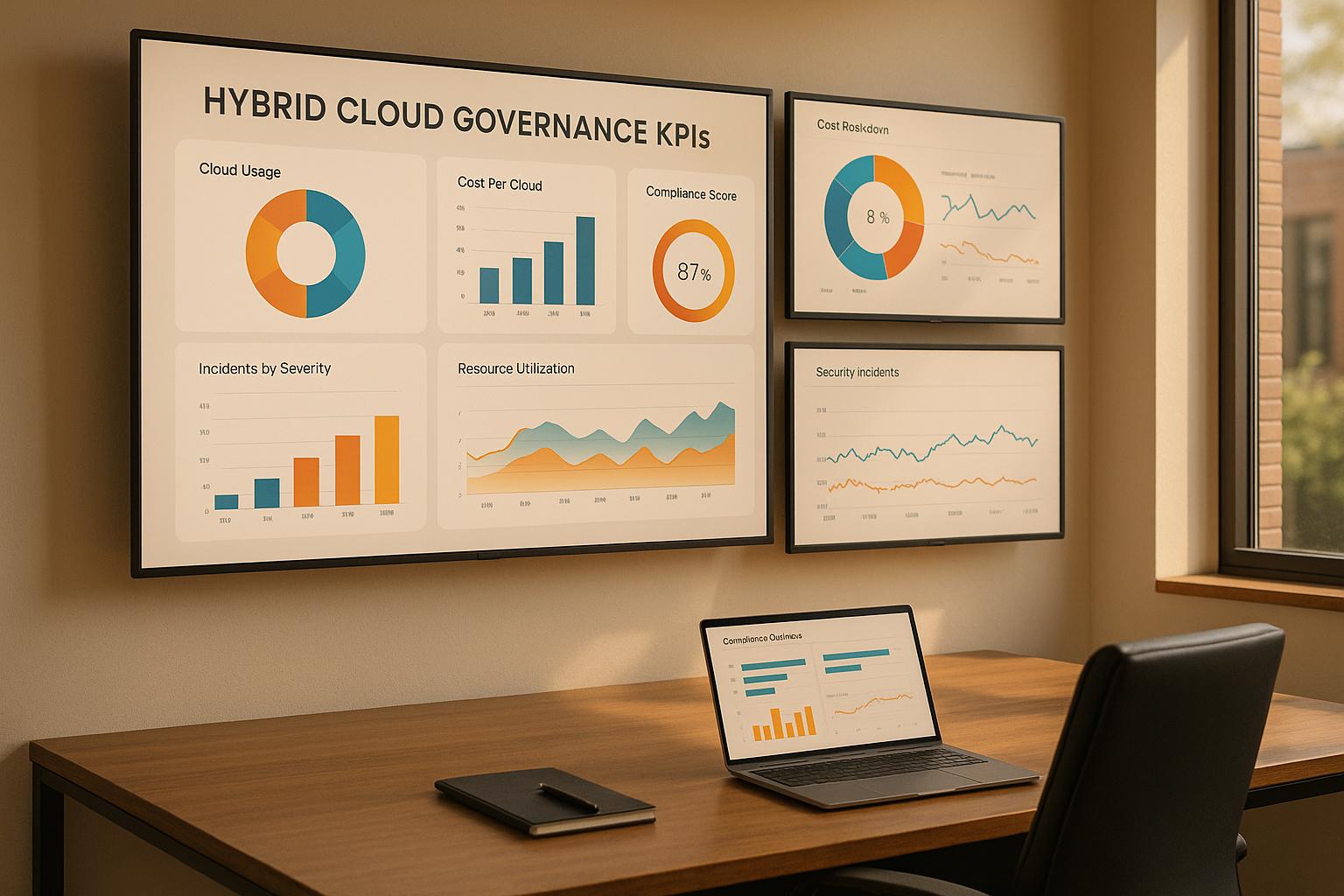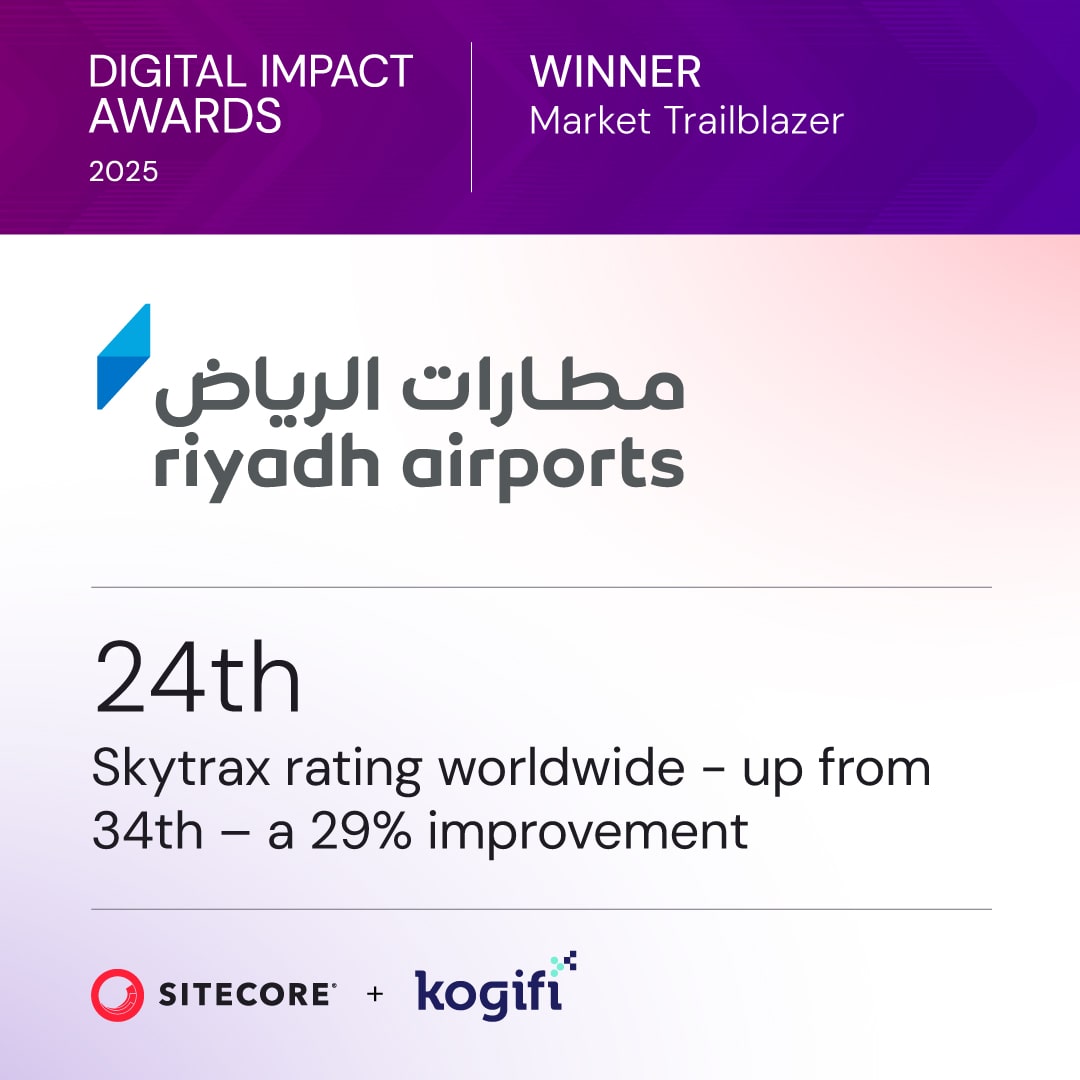Hybrid cloud governance KPIs help businesses manage complex IT environments by tracking performance, security, costs, and operations. These metrics ensure efficient resource use, compliance with regulations, and cost control. Without them, organizations risk overspending, security breaches, and inefficiencies.
Key Highlights:
- Performance KPIs: Measure uptime, latency, resource utilization, and app response times.
- Security KPIs: Track compliance, resolve vulnerabilities quickly, and monitor access attempts.
- Financial KPIs: Analyze costs per transaction, budget adherence, and forecast accuracy.
- Operational KPIs: Evaluate automation, resource efficiency, and incident resolution times.
Why This Matters: Businesses using well-defined KPIs report increased productivity (up to 40%), reduced costs (up to 50%), and improved agility (35%). These metrics provide actionable insights, helping organizations optimize hybrid cloud setups and align IT with business goals.
To implement KPIs effectively:
- Align metrics with business priorities.
- Standardize measurements across platforms.
- Use tools for real-time monitoring and reporting.
- Regularly review and refine KPIs to stay relevant.
Hybrid cloud KPIs are not just numbers - they drive better decisions, streamline operations, and ensure long-term success.
Essential KPIs for Cloud Architects: Measuring Your Impact in the Enterprise
Main Categories of Hybrid Cloud Governance KPIs
To ensure seamless management of hybrid cloud environments, organizations rely on specific key performance indicators (KPIs) to monitor and optimize their operations. These KPIs can be grouped into four major categories, each addressing critical aspects of hybrid cloud management. By understanding these categories, businesses can develop a well-rounded strategy to keep their hybrid infrastructure running smoothly.
Performance KPIs
Performance KPIs assess how effectively your hybrid cloud infrastructure delivers services to users and applications. These metrics focus on reliability, speed, and resource efficiency across both public and private cloud environments.
Some key performance metrics include:
- System Uptime: Tracks the percentage of time services remain available. A common target is 99.9% uptime, which translates to about 8.77 hours of downtime annually.
- Latency: Measures response times between different components of the hybrid setup, helping to identify bottlenecks that could disrupt user experience.
- Resource Utilization: Monitors the use of compute, storage, and network resources, such as CPU usage, memory consumption, and storage capacity.
- Application Response Times: Evaluates how quickly applications process requests, with many organizations aiming for under 200 milliseconds for critical business apps.
These metrics ensure users can access services reliably. Poor performance metrics often signal deeper infrastructure issues that need immediate resolution.
Security and Compliance KPIs
In hybrid cloud environments, security and compliance KPIs are essential for minimizing risks. With 70% of company leaders in a 2023 survey affirming the importance of compliance regulations, these metrics play a key role in safeguarding operations.
Important security KPIs include:
- Percentage of Policies in Compliance: Tracks adherence to regulatory requirements across all cloud environments.
- Time to Resolve Security Issues: Measures how quickly critical vulnerabilities are addressed, with a best practice target of resolution within 24 hours.
- Access Attempt Monitoring: Tracks both successful and failed login attempts to identify potential threats, including unusual access patterns or compromised accounts.
Real-world examples underscore the importance of these KPIs. In 2016, Uber suffered a data breach exposing the information of 57 million users due to weak security practices. This incident cost the company $148 million in damages. Additionally, nearly 98% of organizations have dealt with third-party breaches in the past two years, highlighting the need for continuous security monitoring.
Financial KPIs
Financial KPIs help businesses manage costs and improve the return on investment (ROI) for hybrid cloud operations. These metrics ensure budgets are used effectively and resources are optimized.
Key financial metrics include:
- Cost per Transaction: Identifies the expense of processing individual transactions, helping pinpoint cost-effective services and areas for optimization.
- Cloud Spend Forecast Accuracy: Compares predicted costs with actual expenses to refine budget planning.
- Budget Adherence: Tracks whether spending aligns with allocated budgets across departments or projects.
Organizations with strong financial KPIs often see substantial benefits. For instance, companies with hybrid cloud strategies report up to a 30% improvement in operational ROI compared to traditional IT setups, along with an annual IT cost reduction of 15–20%.
"What gets measured gets managed." – Peter Drucker
Additional financial KPIs include cost allocation metrics, which detail expense distribution, and resource utilization costs, which highlight underused assets and potential savings.
Operational KPIs
Operational KPIs focus on the efficiency of hybrid cloud operations, emphasizing automation, resource management, and streamlined processes. These metrics reveal how well systems and teams collaborate to deliver services.
Key operational metrics include:
- Time Saved Through Automation: Tracks hours saved by automating tasks like provisioning, scaling, and maintenance.
- Efficiency of Resource Usage: Measures how effectively cloud resources are utilized, including server utilization rates, storage efficiency, and network bandwidth.
- Number of Automated Processes: Counts the manual tasks converted into automated workflows, reducing human error and boosting efficiency.
Other critical metrics include:
- Mean Time to Provision Resources: Evaluates how quickly new resources are deployed.
- Incident Resolution Time: Tracks how fast operational issues are identified and resolved.
- Change Success Rate: Measures the percentage of infrastructure changes implemented without causing disruptions.
Selecting and Standardizing Hybrid Cloud Governance KPIs
As hybrid cloud strategies gain traction - 77% of companies globally now use them, according to IBM research - the need for effective governance metrics has never been more pressing. Establishing the right KPIs (Key Performance Indicators) plays a pivotal role in improving performance, security, financial management, and operations across hybrid environments.
Choosing the Right KPIs for Your Organization
The key to effective KPI selection is ensuring they align directly with your business goals. Instead of tracking an overwhelming number of metrics, focus on a handful that provide actionable insights.
Applying the SMART criteria - Specific, Measurable, Attainable, Relevant, Time-Bound - can help ensure your KPIs are both practical and impactful. In fact, limiting your selection to no more than five key metrics is often the most effective approach. This sharp focus ensures your team prioritizes what truly matters, leaving no room for unnecessary distractions.
When choosing KPIs, think about how input parameters link to outputs. For example, if your goal is cost optimization, metrics like cost per transaction or budget adherence might be essential. Aligning these metrics with your business priorities requires collaboration with key stakeholders, ensuring technical tracking supports broader strategic objectives.
"KPIs provide unique measurements of your digital transformation's health and allow you to build on success because what gets managed, measured, and reported gets done." - AWS Cloud Enterprise Strategy Blog
It’s also important to regularly revisit your KPIs. As business priorities and cloud architectures evolve, periodic reviews help keep your metrics relevant and effective. This adaptability ensures your governance framework remains aligned with current challenges.
Once your KPIs are finalized, the next step is standardizing them across your hybrid infrastructure.
Standardizing Metrics Across Platforms
Standardization is the backbone of effective hybrid cloud governance. Without consistent measurement approaches, comparing performance across public cloud services and on-premises infrastructure becomes nearly impossible.
Start by standardizing measurement units. For instance, if you’re tracking latency, ensure all platforms report it in milliseconds rather than mixing units like seconds and milliseconds. Similarly, use consistent storage measurements, such as gigabytes or terabytes, across your systems.
The process begins with identifying the metrics that matter most to your organization. Core areas often include latency, cost efficiency, availability, resource usage, and utilization. Once these metrics are defined, establish baseline measurements and adjust them as your environment evolves.
Using monitoring tools that work seamlessly across both cloud and on-premises environments is essential. These tools should enable metric correlation, anomaly detection, and comprehensive analysis through a unified dashboard.
Uniform monitoring processes are equally important. Consistent data collection intervals, alerting thresholds, and reporting formats ensure a cohesive view of your hybrid environment. Automating these processes with Infrastructure as Code (IaC) can streamline monitoring agent deployment and configuration, reducing discrepancies between platforms.
Custom dashboards can also enhance visibility. By presenting standardized data in real time, these dashboards help both technical teams and executives make informed decisions.
With standardized metrics in place, organizations can move toward phased adoption and integration of KPIs into their governance frameworks.
Step-by-Step KPI Adoption and Integration
Rolling out a KPI framework is best done in phases. Attempting to implement everything at once often leads to resistance and poor adoption. Instead, start by establishing a hybrid cloud governance model that aligns with your business objectives. This should cover resource ownership, cost accountability, and lifecycle management to avoid inefficiencies.
As Lanir Shacham, CEO of Faddom, advises:
"Establish a hybrid cloud governance model that aligns with business goals, covering resource ownership, cost accountability, and lifecycle management to avoid sprawl and resource wastage."
Here’s a phased approach to KPI adoption:
- Phase One: Introduce FinOps practices to align cloud spending with business value. Develop a catalog of pre-approved cloud services and configurations.
- Phase Two: Standardize automation using Infrastructure as Code tools. Implement centralized Identity and Access Management (IAM) solutions to ensure consistent security across hybrid environments.
- Phase Three: Deploy continuous monitoring platforms to track your selected KPIs in real time. Incorporate multi-layered security strategies, including encryption and access controls.
To further streamline the process, consider creating a Cloud Center of Excellence (CCoE) or partnering with a Cloud Managed Service Provider. These resources bring the expertise needed to implement sophisticated KPI frameworks without overburdening internal teams.
Clear policies and defined roles are also critical. Establish guidelines for cloud usage, data security, and compliance, ensuring accountability measures are in place. This keeps operations efficient even as governance oversight increases.
Continuous evaluation is the final piece of the puzzle. Regularly analyze costs, performance, and security to identify areas for improvement. If KPIs reveal negative trends, implement corrective actions promptly. Effective governance depends on executive alignment, consistent data collection, and the ability to turn KPI insights into actionable improvements.
sbb-itb-91124b2
Implementation and Continuous Improvement of KPIs
Rolling out hybrid cloud governance KPIs successfully takes more than just setting them up. It requires a deliberate approach that includes strong measurement practices, ongoing refinement, and embedding KPI tracking into everyday operations. This ensures your governance framework delivers consistent value.
Setting Up KPI Measurement and Reporting
To get started, enforce tagging policies across your hybrid cloud environment. These tags should capture critical details such as business unit, project code, environment type, and cost center. Consistent tagging helps ensure accurate KPI tracking and cost attribution. Automating this process is key to maintaining uniformity as your environment grows.
Next, establish clear performance benchmarks that align with your business goals. For example, you might target a 99.9% uptime rate. Use monitoring tools equipped with automated alerts to flag issues like budget overruns or spikes in response times.
Set up monitoring tools that provide unified visibility across both cloud and on-premises systems. Centralized dashboards displaying key metrics give stakeholders a clear picture of your governance framework’s performance. Automate reporting to generate regular updates, from operational insights to executive summaries, ensuring everyone stays informed.
Once your measurement and reporting systems are in place, make a habit of regularly reviewing and fine-tuning your KPIs to adapt to shifting business needs.
Monitoring and Refining KPIs Over Time
After establishing your measurement framework, continuous monitoring is essential to keep your KPIs relevant and actionable. Without regular evaluation, their effectiveness can diminish. Schedule routine reviews of your cloud monitoring strategies to ensure they’re still effective and make adjustments as needed. Keep an eye on trends and update your KPIs to reflect the changing demands of your business.
Trend analysis and periodic updates are crucial for tracking cloud adoption progress, improving efficiency, and showcasing measurable benefits to stakeholders. Dive into resource utilization data regularly to confirm that allocations align with actual usage patterns. Sometimes, refining your KPIs might mean retiring outdated metrics and introducing new ones that better align with your evolving hybrid cloud strategy.
Integrating KPI Tracking Into Governance Processes
For long-term success, KPI tracking needs to become a seamless part of daily operations. This ensures that measurement and refinement efforts actively support decision-making. Assign specific roles for governance and performance management, integrate KPI reviews into existing team meetings, and create clear escalation paths to address issues promptly. Equip your teams with training on hybrid cloud tools and best practices to enhance their effectiveness.
Instead of adding more meetings to the calendar, fold KPI reviews into your current workflows. For example, include performance updates in weekly operations reviews, monthly business meetings, or quarterly planning sessions. Regularly reviewing performance data can lead to targeted improvements, such as rebalancing workloads between cloud and on-premises systems to boost both performance and cost-efficiency.
Conclusion and Key Takeaways
Hybrid cloud governance KPIs play a crucial role in driving successful digital transformation. When used effectively, they give businesses the visibility and control needed to fine-tune hybrid environments while maintaining strong security and compliance standards.
This approach leads to real, measurable results. Organizations with clearly defined KPIs are 12% more likely to meet business objectives and can experience a 20% increase in operational efficiency. These gains directly impact profitability and provide a competitive edge.
However, your KPI strategy can't remain static. Metrics that don't adapt to the ever-changing cloud landscape quickly lose their relevance. Take the example of a mid-sized software company that routinely overestimated its cloud budget by 30% each quarter. Auto-scaling services expanded capacity during high-traffic periods but failed to scale back, leading to $45,000 in unnecessary computing costs every quarter. This highlights the importance of continuous monitoring and regularly refining your KPIs.
Focusing on trends rather than isolated metrics offers deeper insights. Performance trends help reveal patterns that are essential for making timely adjustments. Regularly reviewing KPIs is especially important after major deployments, during unexpected billing issues, or when scaling operations becomes a priority.
But tracking metrics is just the beginning. The most successful organizations go a step further by acting decisively on the insights they uncover. This involves aligning stakeholders, establishing consistent data collection processes, and having predefined corrective actions ready to address negative trends quickly and minimize business disruption.
FAQs
How can businesses keep their KPIs relevant as their hybrid cloud environments change over time?
To ensure KPIs remain effective in the ever-changing world of hybrid cloud environments, businesses need to regularly revisit and refine them. This helps keep them aligned with shifting objectives, emerging technologies, and evolving organizational priorities. Key areas to monitor include cost efficiency, security, and performance - all of which should be adjusted based on real-time data and feedback.
By reassessing KPIs periodically, organizations can ensure these metrics remain actionable and relevant, maintaining focus on their hybrid cloud strategy. This ongoing process supports smarter decision-making and allows businesses to get the most out of their cloud investments.
What are the best tools for monitoring and reporting hybrid cloud governance KPIs in real time?
When it comes to keeping tabs on hybrid cloud governance KPIs in real-time, tools like SolarWinds Observability Self-Hosted and NetApp Cloud Insights are excellent options. These platforms offer features like intuitive visualizations, dynamic topology mapping, and detailed dashboards, making it easier to monitor performance and compliance.
Using these tools, businesses can get clear, actionable insights into their hybrid cloud setups, helping them maintain better governance and ensure smoother operations.
How do hybrid cloud governance KPIs help businesses boost efficiency and cut costs?
Hybrid cloud governance KPIs are key to boosting efficiency and cutting costs. They provide detailed insights into resource usage, spending trends, and adherence to governance policies. With these metrics, businesses can identify areas of inefficiency, better allocate resources, and eliminate wasteful expenses.
By monitoring and evaluating these KPIs, organizations gain the ability to make informed, data-backed decisions. This helps fine-tune cloud performance, strengthen operational control, and align the hybrid cloud setup with broader business goals. The result? Smarter cost management and a noticeable uptick in productivity.








































